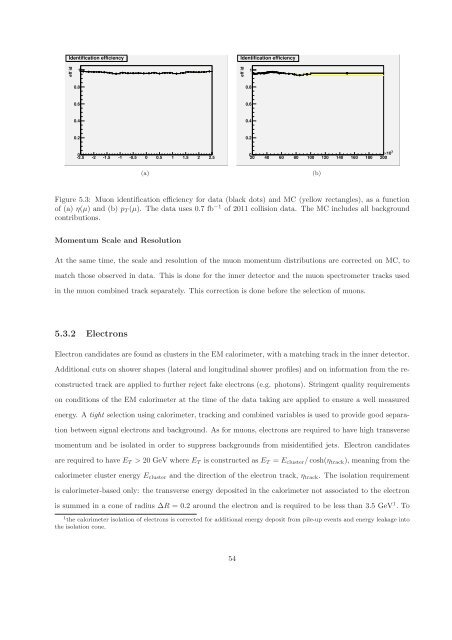CERN-THESIS-2012-153 26/07/2012 - CERN Document Server
CERN-THESIS-2012-153 26/07/2012 - CERN Document Server
CERN-THESIS-2012-153 26/07/2012 - CERN Document Server
Create successful ePaper yourself
Turn your PDF publications into a flip-book with our unique Google optimized e-Paper software.
Identification efficiency<br />
eff id<br />
1<br />
0.8<br />
0.6<br />
0.4<br />
0.2<br />
0<br />
2.5 2 1.5 1 0.5 0 0.5 1 1.5 2 2.5<br />
(a)<br />
Identification efficiency<br />
eff id<br />
1<br />
0.8<br />
0.6<br />
0.4<br />
0.2<br />
3<br />
0<br />
× 10<br />
20 40 60 80 100 120 140 160 180 200<br />
Figure 5.3: Muon identification efficiency for data (black dots) and MC (yellow rectangles), as a function<br />
of (a) η(µ) and (b) pT(µ). The data uses 0.7 fb −1 of 2011 collision data. The MC includes all background<br />
contributions.<br />
Momentum Scale and Resolution<br />
At the same time, the scale and resolution of the muon momentum distributions are corrected on MC, to<br />
match those observed in data. This is done for the inner detector and the muon spectrometer tracks used<br />
in the muon combined track separately. This correction is done before the selection of muons.<br />
5.3.2 Electrons<br />
Electron candidates are found as clusters in the EM calorimeter, with a matching track in the inner detector.<br />
Additional cuts on shower shapes (lateral and longitudinal shower profiles) and on information from the re-<br />
constructed track are applied to further reject fake electrons (e.g. photons). Stringent quality requirements<br />
on conditions of the EM calorimeter at the time of the data taking are applied to ensure a well measured<br />
energy. A tight selection using calorimeter, tracking and combined variables is used to provide good separa-<br />
tion between signal electrons and background. As for muons, electrons are required to have high transverse<br />
momentum and be isolated in order to suppress backgrounds from misidentified jets. Electron candidates<br />
are required to have ET > 20 GeV where ET is constructed as ET = Ecluster/cosh(ηtrack), meaning from the<br />
calorimeter cluster energy Ecluster and the direction of the electron track, ηtrack. The isolation requirement<br />
is calorimeter-based only: the transverse energy deposited in the calorimeter not associated to the electron<br />
is summed in a cone of radius ∆R = 0.2 around the electron and is required to be less than 3.5 GeV 1 . To<br />
1 the calorimeter isolation of electrons is corrected for additional energy deposit from pile-up events and energy leakage into<br />
the isolation cone.<br />
54<br />
(b)















